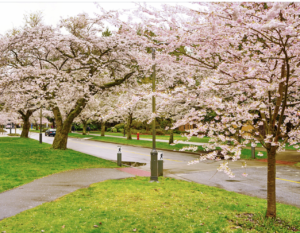Anúncios
The ambitious Travelling Village brings 19 digital nomad families together for a four-month global co-living and co-traveling experience
Prior to having parents, Nikolaj Astrup and Michelle Rødgaard-Jessen worked as digital nomads for six years, traveling to China, France, Spain, Nepal, and Argentina. Naturally, they envisioned traveling after having kids. The family’s initial six-month journey to France and Mexico showed the difficulties of making friends and finding assistance when traveling with two small children.
It’s common to feel alone in a nuclear household with kids. But living alone never seemed natural “Astrup recalls their first family vacations.
Anúncios
In response to the need for community, Astrup and Rødgaard-Jessen, together with three other families, created The Travelling Village, a platform for digital nomad families to exchange experiences in three Asian regions.
The initiative provides co-housing, social events, work groups, and shared childcare for working parents. Through five-week stays in each city and family decompression times, it fosters a community and establishes routines for digital nomads who lose their regular support network.
Anúncios
From 15 January 2024 to 14 May 2024, the experiment has taken place in Hoi An, Vietnam; Ko Lanta, Thailand; and Kyoto, Japan. From 82 varied candidates, 19 families (70 people, 34 children aged one to 14) from Denmark, the US, India, Ireland, Italy, and the Netherlands were chosen. Everyone wanted to have a family while traveling and working.
“No house. Community is difficult while traveling. It’s difficult in a place where you don’t speak the language or culture “. Since 2019, his family has slowly traveled as one of the four founding families.
Astrup and Rødgaard-Jessen’s professional experiences offered insight into community dynamics and various lifestyles. Astrup ran a firm that organized retreats for entrepreneurs, while Rødgaard-Jessen works with freelancers to help them begin or grow their businesses. Danish cohousing programs, bofaellesskaber or “living communities” from the 1970s, inspired their concept. Astrup actively researched cohousing best practices and used them in the project.
Keeping 20 families is ideal for intimate ties and effective decision-making. They carefully selected individuals over a year. “We actively mentioned the potential negative aspects,” Astrup adds, including making choices with families with differing beliefs.
Location design using “close proximity” is another method. To improve walkability and privacy, families are urged to locate hotels within 1 to 1.5 miles of each other. “If families needed to withdraw because they needed privacy, the community would not be bothered because there are so many others within the group,” says Astrup.
Each digital nomad community, whether amid rice fields in Hoi An, a central hotel in Ko Lanta, or dispersed lodgings in Kyoto, was designed to reconcile communal living with family requirements. Community lunches twice a week are the main way to gather everyone.
About half the families homeschool, some for a few hours a day, and use travel as a curriculum extension-Nikolaj Astrup
In the experiment, most parents are self-employed and work nights while caring for their children and homeschooling. About half the families homeschool, some for a few hours a day, and use travel as a curriculum extension. “Some are taking a break,” says Astrup. “Most see how much learning there is just through doing this experience.”
The community’s busy program of two to five daily activities promotes socialization. Group runs, soccer games, introspective co-working, yoga lessons, and cultural enrichment are available. Vietnamese family loved painting with a local watercolourist. They planted mangroves and learned about the environment in Thailand with an eco-focused children’s center. They’ve worked with a Kyoto play center owner to offer programs where their children may play, create, and learn from local youngsters.
Astrup says parents take turns keeping the kids so others can go on excursions, but it depends on the kids’ comfort with other people. “It’s quite common for the older children to accompany other families to community events,” adds. Single mother Asha Niederman discusses other parents caring for her two-year-old kid so she could attend a Thai mother’s event. “My son is especially close now to a few of the families and feels very happy staying with them if I ever need to run an errand,” she says.
All participants influence daily life at each site via 17 workgroups that manage meals, activities, money, and other infrastructure, including communications. Some groups concentrated on pre-trip responsibilities like housing, while others, such community meals and finance, remained during the journey.
“If you’re on a group tour, it’s top-down, meaning there’s someone in charge,” he explains. You may complain if anything goes wrong. It’s bottom-up here. We’re in control and must cooperate.” Saying, “You’re not going to have the same values around how you raise your kids or manage your money.” 19 families provide complications. Workgroups and decision-making frameworks actively include all community members in handling conflicts, says Astrup.
However, disagreements over group fund spending have led to a voting mechanism that requires unanimity for greater expenditures. Family size-based community deposits of roughly US$3,000 funded communal meals, children’s activities, and special events. Beyond this, families pay for flights, meals, and accommodation, which vary by budget.
The experiment had challenges. Five families’ Hoi An housing was moldy when they arrived. They tried to remain together, but the only option was more costly and further away.
Families have also had to balance employment, socializing, and family obligations while adapting to new settings every few weeks, including finding diapers and what their children would eat. “You would think you have all the time in the world to do things, but every day feels like triage,” he adds. He says discussions and activities distract him.
It seems like you have all the time in the world, yet every day is triage – Andy Cotter
Cotter’s wife, Irene Genelin, thinks the network helps parents with other issues. “When our daughter didn’t want to do things, one of us had to remain behind. She can now contact community adults. She thinks this allows her husband and her more flexibility to do things together or alone.
Genelin wants to remain longer than five weeks after becoming adjusted to her surroundings, particularly in Vietnam. “It takes a certain amount of effort to figure out your bearings – where you live, where to get groceries,” he says. “I also started forming relationships with locals and their businesses – cafe owners, street vendors.” She hopes they can remain in one country for two months.
Niederman also prefers slower travel and exploring a single country: “I would pick one country and go to three very different cities within that country and stay for a longer period rather than fly to different countries,” she says, adding that she would repeat this experiment when her son is older and doesn’t need naps or bedtime.
As the experiment nears its completion, Astrup and Rødgaard-Jessen consider expanding it to include various populations including pensioners and university students, and partnering with local community efforts to have a greater effect. Astrup also observes that most families, including Genelin and Cotter’s, want to participate in future trial, but schedule, location, and job obligations limit them.
For the two entrepreneurs, their foundation reflects a deep social need for connection. She says: “It has been beautiful to be close to people this way – watching our kids grow, being together and sharing everyday life.”






